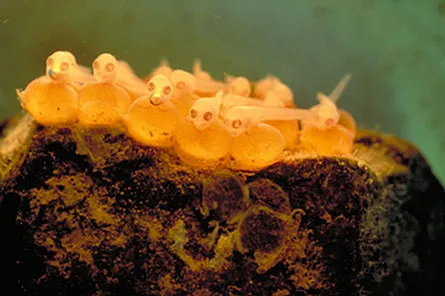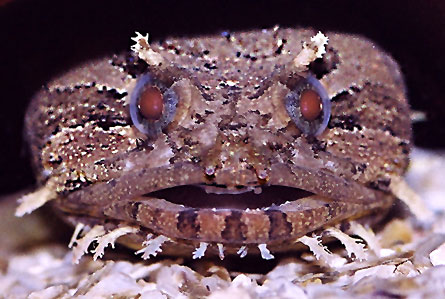No matter how off-key you might be, you’re still singing like a nightingale. Or a fish.


Studies of the nervous systems of larval toadfish have revealed brain circuitry similar to that controlling the vocal muscles in frogs, birds and mammals, says Andrew H. Bass of CornellUniversity.
Vertebrates croak, sing, ribbit and roar using very different muscles. But Bass and his colleagues propose that a basic network of the nerves setting the rhythms and orchestrating those muscles originates in the same area of the brain and spinal column.
With appearances in such a broad sweep of vertebrates, that neural design probably arose in some long-ago ancestor of all these creatures, he and his colleagues report in the July 18 Science. The fish they studied belong to a lineage that diverged from other vertebrates some 400 million years ago. “The neural basis for vocal communication is very ancient,” Bass says.
Bass and his colleagues have been studying the neuroscience of fish vocalizations for decades. “Most people don’t think about fish making sounds,” he says. Many fish do, though, and in the same contexts of love and war in which other vertebrates sing out.
Toadfish make great study subjects for vocalization in part because they’re so loud. “Sometimes just standing near a tank, you can hear them,” Bass says. During courtship, males hum, a noise that to human ears has the basic sound and all the romance of a smoothly running refrigerator.
In touchier situations, such as territorial disputes, males growl. Think lawn mower a block or two away. And toadfish grunts sound like — grunts.
Toadfish larvae, translucent orange with ducklike shapes, prove relatively easy to trace neural development in. The nerves that form eventually control just one pair of muscles that make their swim bladders vibrate to make sound. “You can’t get any simpler than that,” Bass says.
Analyzing the larvae helps clarify evolutionary relationships, he says. By adulthood, animal neurons have moved around from their embryonic positions.
“This is a beautiful example of sorting out what happened through evolution by looking at the developing brain,” says neuroethologist Fabiana Kubke of the University of Auckland in New Zealand.
To the trained eye of a neuroscientist, similarity of the basic neural circuitries is “quite striking,” Kubke says. “They have beautiful data, absolutely beautiful.”
She studies a neural circuit that controls songbird singing muscles, which are quite different from the swim bladders that toadfish vibrate to communicate. Yet she says that to neuroscientists who think about brain evolution, the new paper’s proposal of a shared ancient pathway for vocal communication makes perfect sense. “The word I would use is delightful,” she says.
Looking at the hypothesis from the frog side, “there’s no evidence against it, and some evidence that supports it,” says neuroethologist Erik Zornik at BostonUniversity. Studies of two frog species show that the area proposed as the ancient mother of all croaks is necessary, but not sufficient, for adults to call. Whether the other neural circuits frogs use arose later as add-ons to some ancestral network will be clearer after more studies of how tadpoles develop and what nerves generate rhythms for sound.






